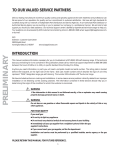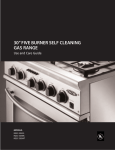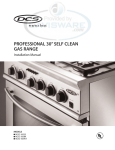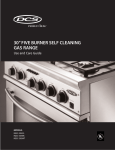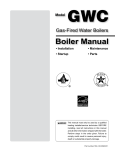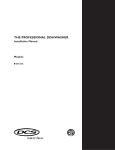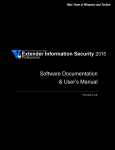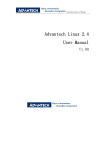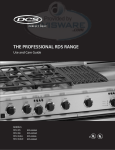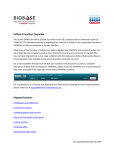Download DCS I RGSC-305PL Specifications
Transcript
Dynamic Cooking Systems, Inc. 30” FIVE BURNER SELF CLEANING GAS RANGE Care and Use Guide Models: ■ ■ ■ ■ ■ ■ RGSC-305SS RGSC-305BK RGSC-305WT RGSC-305GN RGSC-305BL RGSC-305PL A Message To Our Customers Thank you for selecting this DCS Professional 30” Five Burner Self Cleaning Gas Range. Because of this appliance’s unique features we have developed this Care and Use Guide. It contains valuable information on how to properly operate and maintain your new appliance for years of safe and enjoyable cooking. To help serve you better, please fill out and return the Ownership Registration Card and keep this Guide handy, as it will help answer questions that may arise as you use your new appliance. For your convenience, product questions can be answered by a DCS Technical Support Representative by phone: 1-888-281-5698, or Fax: 714-372-7003 or by mail: DCS Attention Customer Service, 5800 Skylab Road, Huntington Beach, CA 92647 WARNING If the information in this manual is not followed exactly, a fire or explosion may result causing property damage, personal injury or death. PRECAUTION Do not store or use gasoline or other flammable vapors and liquids in the vicinity of this or any other appliance. FOR YOUR SAFETY If you smell gas: • Do not try to light any appliance. • Do not touch any electrical switch; do not use any phone in your building. • Immediately call your gas supplier from a neighbor’s phone. Follow the gas supplier’s instructions. • If you cannot reach your gas supplier, call the fire department. Installation and service must be performed by a qualified installer, service agency or the gas supplier. PLEASE RETAIN THIS MANUAL FOR FUTURE REFERENCE. 1 Table Of Contents SAFETY PRACTICES TO AVOID PERSONAL INJURY Read Before Using your new appliance..................................................................................4-6 PARTS IDENTIFICATION.............................................................................................................7-8 BEFORE USING YOUR APPLIANCE.........................................................................................9 COOKTOP USE Burners ............................................................................................................................................10 Simmering .......................................................................................................................................10 Electronic Igniters .........................................................................................................................11 Burner Efficiency and Flame Characteristics ..........................................................................11 Flame Height ..................................................................................................................................12 Burners ............................................................................................................................................12 Burner Grates................................................................................................................................12 Cooking Utensils ...........................................................................................................................13 Control Knobs...............................................................................................................................13 OVEN USE Burners ............................................................................................................................................14 Electric Glow Igniter Coil ...........................................................................................................14 Oven...........................................................................................................................................14-16 To Set The Oven For Baking ......................................................................................................16 Preheating .......................................................................................................................................17 Condensation .................................................................................................................................17 To Get The Best Results..............................................................................................................17 Oven Racks.....................................................................................................................................18 High Altitude Baking .....................................................................................................................19 To Set The Oven For Broiling And Convection Broil...........................................................19 Reheating.........................................................................................................................................19 To Get The Best Results..............................................................................................................19 Oven Racks Position ....................................................................................................................20 Using A Meat Thermometer To Broil And Convection Broil..............................................20 To Use The Oven For Slow Cooking Or Low Temperatures ............................................20 Suggested Temperatures To Keep Food Hot...........................................................................21 Internal Cooking Temperature ...................................................................................................21 2 Table of Contents OVEN SELF-CLEANING Oven Self-cleaning.........................................................................................................................22 Oven Door Lock During Self-clean..........................................................................................22 Before Self-cleaning The Oven ...................................................................................................22 Setting The Oven For Self-clean ................................................................................................23 At the End Of The Clean Cycle ................................................................................................23 CARE AND MAINTENANCE Cooktop ..........................................................................................................................................24 Burner Grates................................................................................................................................24 Burners ............................................................................................................................................25 Igniters .............................................................................................................................................25 Control Knobs-Cooktop And Oven ........................................................................................25 Backguard........................................................................................................................................26 Oven And Door Interior.............................................................................................................26 Oven Racks And Rollers..............................................................................................................27 Frame, Sides, Door Exterior, Heat Defector ..........................................................................27 Door Gasket ..................................................................................................................................27 Oven Light Bulb Replacement....................................................................................................27 Power Failure .................................................................................................................................27 Before You Call For Service........................................................................................................28 If The Cooktop Burners Do Not Light....................................................................................28 Service Information ......................................................................................................................28 WARRANTY ............................................................................................................................................29 SERVICE .....................................................................................................................................................30 3 Safety Practices To Avoid Personal Injury When properly cared for, your new DCS Appliance has been designed to be a safe, reliable cooking appliance.When using this restaurant caliber appliance, use it with extreme care, as this type appliance provides intense heat and can increase the accident potential. Basic safety precautions must be followed when using kitchen appliances, including the following: Read this Care and Use Manual thoroughly before using your new appliance.This will help to reduce the risk of fire, electric shock, or injury to persons. Begin by insuring proper installation and servicing. Follow the installation instructions which came with this appliance. Be sure to have a qualified technician to install and ground this appliance before using. Have the installer show you where the gas supply shutoff valve is located so you will know how and where to turn off the gas to the appliance. If you smell gas, the installer has not done a proper job of checking for leaks.You can have a small leak and therefore a faint gas smell if the connections are not completely tight. Finding a gas leak is not a “do-it-yourself” procedure. Some leaks can only be found with the burner control in the ON position and for your protection it must be done by a qualified service technician. If by some chance a burner goes out and gas escapes, open a window or a door to let the room air out. Do not attempt to use the appliance until the gas has had time to dissipate. Follow the instructions on page 1, “What to do if You Smell Gas”. This appliance has been factory assembled for natural gas. It should be correctly adjusted by a qualified service technician or installer for the type of gas that is used. Do not repair or replace any part of this appliance unless it is specifically recommended in this manual. All other servicing should be referred to a qualified technician. Children should not be left alone or unattended in an area where appliances are in use. They should never be allowed to turn knobs, push buttons, sit or stand on any part of an appliance. Children in walkers, or children crawling can be attracted to the round oven door handle and may grab and open the oven door.This can result in injury from the door being pulled open on a child, or severe burns if the oven is in use and hot. CAUTION: Do not store items of interest to children above or at the back of any appliance. Children could be seriously injured if they should climb onto the appliance to reach these items. Never store anything in the oven or on the cooktop. Flammable materials can catch fire, plastic items may melt or ignite and other types of items could be ruined. Do not hang articles from any part of the appliance or place anything against the oven. Some fabrics are quite flammable and may catch on fire. If the appliance is near a window be certain the curtains do not blow over or near the cooktop burners; they could catch on fire. Do not use water on grease fires.Turn all burners OFF, then smother fire with baking soda or use a dry chemical or foam-type fire extinguisher. 4 Safety Practices To Avoid Personal Injury Never let clothing, pot holders, or other flammable materials come in contact with, or too close to, any burner or burner grate until it has cooled. Fabric may ignite and result in personal injury. Be certain to use only dry pot holders: moist or damp pot holders on hot surfaces may cause burns from steam. Do not use a towel or other bulky cloth in place of pot holders. Do not let pot holders touch hot burners, or burner grates. For personal safety, wear proper apparel. Loose fitting garments or hanging sleeves should never be worn while using this appliance. Some synthetic fabrics are highly flammable and should not be worn while cooking. Do not use aluminum foil to line any part of the oven or cooktop. Using a foil liner could result in a fire hazard, or the obstruction of the flow of combustion and ventilation air. Foil is an excellent heat insulator and heat will be trapped underneath it.This trapped heat can upset the cooking performance and can damage the finish of the oven or the cooktop parts. WARNING: This appliance is for cooking. Based on safety considerations, never use the oven or cooktop to warm or heat a room. Also, such use can damage the cooktop or oven parts. When using the cooktop: Do not touch the burner grates or the immediate surrounding area. Areas adjacent to the burners may become hot enough to cause burns. When using the oven: Do not touch the interior surfaces of the oven, the exterior area immediately surrounding the door or the back trim. The surfaces directly above the oven door may be hot if the oven has been operated with the door open, or if something has prevented the door from sealing. Never leave the cooktop unattended when using high flame settings. Boil overs cause smoking and greasy spill overs may ignite. More importantly, if the burner flames are smothered by a severe boil over which effects the igniter, unburned gas will escape into the room. See page 1. Only certain types of glass, heat-proof glass-ceramic, ceramic, earthen ware, or other glazed utensils are suitable for cooktop use. This type of utensil may break with sudden temperature changes. Use only on low or medium flames settings according to the manufacturer’s directions. Do not heat unopened food containers; a build up of pressure may cause the container to burst. During cooking, set the burner control so that the flame heats only the bottom of the pan and does not extend beyond the bottom of the pan.This could heat and/or melt the handles. Always use utensils that have flat bottoms large enough to cover the burner. The use of undersized utensils will expose a portion of the flame to direct contact and may result in ignition of clothing. To minimize burns, ignition of flammable materials and unintentional spill overs, position handles of utensils inward so they do not extend over adjacent work areas, cooking areas, or the edge of the cooktop. 5 Safety Practices To Avoid Personal Injury Hold the handle of the pan to prevent movement of the utensil when stirring or turning food. GREASE IS FLAMMABLE. Let hot grease cool before attempting to handle it. Avoid letting grease deposits collect around the cooktop burners. Clean after each use or boil over. For proper lighting and performance of the cooktop burners, keep the burner ports clean. It may be necessary to clean these when there is a boil over or when the burner does not light, even though the electronic igniters click. Clean the cooktop with caution. Avoid steam burns; do not use a wet sponge or cloth to clean the cooktop while it is hot. Some cleaners produce noxious fumes if applied to a hot surface. Follow directions provided by the cleaner manufacturer. Be sure all the range and/or cooktop controls are turned off and the appliance is cool before using any type of aerosol cleaner on or around the appliance.The chemical that produces the spraying action could, in the presence of heat, ignite or cause metal parts to corrode. Place oven racks in desired position while the oven is cool. If a rack must be moved while the oven is hot, do not let the pot holders contact the hot interior of the oven. Use care when opening the oven door. Let hot air or steam escape before removing or replacing foods. Do not rub, damage, move or remove the door gasket. It is essential for a good seal during baking. Clean the ventilator hood and filters above the range or cooktop frequently so grease from cooking vapors does not accumulate on them. Turn the ventilator OFF in case of fire or when intentionally “flaming” liquor or other spirits on the cooktop.The blower, if in operation, could unsafely spread the flames. Do not obstruct the flow of combustion or ventilation air to the appliance. Be sure a fresh air supply is available. For safety reasons and to avoid damage to the appliance never sit, stand, or lean on the oven door or cooking surface. Service should only be done by authorized technicians.Technicians must disconnect the power supply before servicing this appliance. California Proposition 65 - Warning:The burning of gas cooking fuel generates some by-products which are known by the State of California to cause cancer or reproductive harm. California law requires businesses to warn customers of potential exposure to such substances.To minimize exposure to these substances, always operate this unit according to the instructions contained in this booklet and provide good ventilation to the room when cooking with gas. 6 Parts Identification 13 1 2 11 3 10 9 4 5 8 12 6 7 PARTS LIST: 1. Island Trim 2. Burner Grates 3. Cooktop Burner Control Knobs 4. Oven Control Knob 5. Rack Rollers (Supports) 6. Oven Door 7.Window 8. Oven Door Gasket 9. Oven Indicator Lights 10. Oven Light Switch 11. Selector Switch 12. Standard Oven Racks 13. Rating Plate (on back panel) 7 Parts Identification OVEN INTERIOR 8 7 2 5 6 3 4 1 1. Oven Door Handle 2. Oven Thermostat Sensing Bulb 3. Baffle 4. Convection Fan (center back wall of oven can behind baffle) 5. Oven Lights 6. Broiler Burner (behind glass) 7. Oven Door Lock 8. Heat Shield 8 Before Using Your Appliance 1. Remove all packaging materials and labels from your appliance. If the installer has not set up your appliance, do it now. Check that you have the following items: COOKTOP 5 burner head assemblies, burner caps and grates Backguard (if other than island installation) OVEN OFF 4 standard oven racks 1 two-piece broil pan BAKE BAKE BROIL CLEAN OVEN ON HEATING DOOR LOCKED 2. Place the oven racks in the proper position before turning on the oven. For correct rack position check your recipe. The most frequently used position is number 2. The rack positions are numbered from the bottom as in the floors of a building. 4 3 2 1 Do not use aluminum foil to cover the oven racks or to line the oven. Heat can be trapped beneath the foil, this can cause damage to the oven and the food may not cook correctly. 3. Before baking or broiling: One at a time turn on the oven and broiler burners for 20 to 30 minutes each.This burns off the manufacturing oils used by the factory.Turn the oven burner on to 450ºF and then the broiler burner on to “Broil”.Turn on the ventilator above your range while these burners are on, as there will be an odor. 9 Cooktop Use BURNERS Cap Simmer Flame Brass Port Ring Your new professional gas range is equipped with burners typical of those used in restaurants.These burners are designed for maximum cleanability and controllability.The large cap spreads the simmer burner heat out to avoid too much heat being concentrated on the center of the pan.The simmer burner is always on when the burner is in use.The burner should never be operated if the cap is not in place. All the cooktop burners have electronic spark ignition to eliminate continuously burning pilots, when the main burner is on and the flame is blown out, it will relight. Burner Location 4 2 3 1 5 1 2 3 4 5 Max. Btu/hr Nat LP 16,000 14,000 16,000 14,000 17,500 14,000 16,000 14,000 16,000 14,000 Low/Simmer Btu/hr Nat LP 500-1,200 500-1,200 500-1,200 500-1,200 500-1,200 500-1,200 500-1,200 500-1,200 500-1,200 500-1,200 SIMMERING Your new professional cooktop has exceptionally low simmering capabilities.The large cap serves as a heat diffuser to spread out the heat to avoid having a center hotspot. Keep in mind that because of the high heat capacity of the outer burner, and the mass of the cast iron burner grates (they retain heat longer than lighter, conventional grates) some foods may continue to cook by retained heat after the burner has been turned off. When lighting the simmer burner, turn the main burner knob down to the simmer burner position. Should a strong draft or boil over extinguish the simmer flame it will relight automatically as the main burner would. Simmer Flame 10 Cooktop Use ELECTRONIC IGNITERS IGNITER (keep clean) If a burner does not ignite, listen for the clicking sound. If the igniter is not clicking,TURN OFF THE BURNER. Check the circuit breaker for a blown fuse or a tripped circuit breaker. If the igniter still fails to operate, see page 28, “Before Calling For Service”.To light the burner manually, see page 27. NOTE: If you are using propane gas, a slight pop or flash may occur at the burner ports a few seconds after the burner has been turned “off ”.This “extinction pop” is normal for propane gas. BURNER EFFICIENCY AND FLAME CHARACTERISTICS It is necessary to keep the burner ports and the igniters clean for proper lighting and efficient performance of the cooktop burners. The burner flame should burn completely around the burner with no excessive noise or lifting.The flame should be blue in color and stable with no yellow tips. An improper air-gas mixture may cause either a burner flutter or a yellow tipped flame. A technician should adjust the flame. During initial use, foreign particles in the gas line, or dust in or in the air around the appliance may cause an orange flame.This will disappear with use. 11 Cooktop Use FLAME HEIGHT The correct height of the flame mainly depends on the size of the bottom of the cooking utensil, the material of the cooking utensil, the amount and type of food and the amount of liquid in the utensil. Following are some basic rules for selecting flame height. • For safety reasons the flame must never extend beyond the bottom of the cooking utensil. Never allow flames to curl up the side of the pan. • Utensils which conduct heat slowly (such as glass-ceramic) should be used with medium to low flames. If you are cooking with a large amount of liquid, a slightly larger flame can be used. BURNERS SEALED TOP BURNERS (w/ Grates removed) The Sealed Top Burners must be kept clean. Cleaning of the sealed top burners should include the igniter. The cooktop burners have an infinite number of heat settings and there are no fixed positions on the control knobs between HI and LO. To turn the cooktop burner on, push in on the control knob and turn it counterclockwise to the “LITE” position. An audible clicking sound will be heard. When the gas has been ignited by the electronic spark igniter, turn the knob to the desired setting. (This step turns off the igniter and the clicking sound should stop.) OFF LITE HI SIM LO NOTE: The igniter will continue to click as long as a control knob is in the “LITE” position. CAUTION: When turning on any cooktop burner, be sure to stop at the “LITE” position before turning the burner to a flame setting for cooking. If the burner is not lit and it is turned beyond the “LITE” position, to HI, MEDIUM, or LO, there will be a burst of flame when the burner does light. This could cause burns or damage to the surrounding countertop. BURNER GRATES The burner grates are heavy cast iron.They were designed in sections to make them easier to remove and clean. 12 Cooktop Use COOKING UTENSILS For best results we recommend using Professional Cookware.This type of utensil can be found at your finer department stores, specialty cooking shops, or Restaurant Supply Stores. If using regular cookware be very careful if the pans have plastic handles, as these large professional size burners can flame up on the outside of the pan and melt or bubble the handles. CONTROL KNOBS The control knobs are readily associated with the burners they control.The cooktop control knobs are labeled and in front of the burners.The oven control is placed slightly lower than the other control knobs.This is due to the physical size of the commercial type thermostats used on the product. 13 Oven Use BURNERS Your new professional gas range is equipped with bake and broil burners typical of those used in restaurants.The oven broiler burner is 15,000 Btu/hr and the oven baking burner is 28,000 Btu/hr. ELECTRIC GLOW IGNITER COIL The oven bake and broil burners are equipped with an electric glow igniter and safety system which lights the gas.There will be a delay after the control knob has been turned on to when you actually hear gas arrive at the burner.The burner will ignite after the gas reaches the burner. OVEN Your large new oven can be used in four cooking modes; convection bake, regular bake, convection broil, or regular broil.To help you decide which way to cook your food read this information first. Remember this is a new oven and the thermostat has been checked for accuracy.Your old oven may have had a thermostat that over the years got a little hot or a little cold. Check your recipes for the correct time and temperature and don’t use the old time or temperature you were using to compensate for your old oven being off temperature. CONVECTION BAKING Convection Baking is baking with a fan at the back of the oven circulating the hot air in a continuous pattern around the food.This circulating hot air heats and browns the surface of the food more effectively than in a standard oven.This allows most foods to be cooked at lower oven temperatures or in less time, if baked at the regular temperature.The air is recirculated and reheated. Uncovered, longer cooking foods such as large pieces of meat or other foods that can be cooked in low sided baking utensils or air leavened foods, are where you will see the most savings in cooking time. Using multiple racks at the same time will achieve a good time saving, as you can cook more food at the same time.The number of recipes requiring preheating of the oven is reduced considerably because the heat reaches the food faster as the hot air circulates around the food. Foods Suitable to Cook by Convection: Air Leavened Foods (Angel Food Cake, soufflés, cream puffs, meringue shells) Appetizers Breads Main Dishes Oven Meals (1 to 3 racks) Cookies Pies Poultry Roasts 14 Oven Use REGULAR BAKING Bake is baking with hot air; there is no fan.The air movement comes from natural convection - as the air heats, it moves to the top of the oven.This oven mode is the same as you have been using for baking on one or two racks. Foods Suitable for Baking Appetizers Pies, Cakes Breads Desserts Main Dishes Oven Meals (1 to 2 racks) Poultry Roasts CONVECTION BROILING Convection Broiling is cooking by intense infrared radiation supplied by the broil burner while a fan at the back of the oven circulates hot air in a continuous pattern around the food. Convection broiling cooks the food with better results for thicker cuts of meat.The meat sears on the outside and retains more juices and natural flavor inside with less shrinkage. Foods Suitable for Convection Broiling: rack position (same positions for broiling) Thicker Cuts of Meat (1” or more) #3 Thicker, Irregular-sized Pieces of Poultry (1” or more) #3 Thicker Pieces of Fish (1” or more) #3 Top Browning: Casseroles and Breads #3 REGULAR BROILING Broiling is cooking by intense infrared radiation supplied by the broil burner located at the top of the oven. Foods Suitable for Broiling: rack position Appetizers #4 Meats, Poultry, Fish (under 1”) Top Browning: Casseroles and Breads #4 #3 NOTE: Broiling uses the same rack positions as convection broiling (see convection broiling above and page 20 “Oven Rack Position” for more information). The broiler pan for both broiling and convection broiling should be placed all the way to the back of the oven and centered on the rack for best results. 15 Oven Use Converting Recipes to Convection Baking Low sided baking utensils will give the best results as the hot air can reach all sides of the food easier.The oven temperature can be left the same as the recipe and the food cooked a shorter period of time.The temperature can be lowered 25ºF to 50ºF and the food will probably take the same length of time to cook as the recipe states. If you find that food is adequately browned on the outside, but not done in the center, lower the temperature another 25ºF and add to the baking time.When reducing the temperature always check the food for doneness, a minute or two before the minimum time stated in the recipe, as time can always be added. Some recipes will cook faster then others.There is no way to predict exactly how long each recipe will take when you convert it to convection. Convection will be easier to use after you have used it a few times as you will begin to understand the way it bakes. Selecting Utensils for Convection Baking Cooking by convection does not require any specially designed baking utensils.You probably have many utensils in your kitchen that are suitable to use.When choosing a baking utensil, consider the material, the size and the shape as they all affect the baking time, the palatability and the appearance of the finished product. Metal bakeware (aluminum, steel and cast iron) all result in the fastest cooking time and the best end product. Aluminum pans work best for all types of baked goods. For the best browning, use a pan with a dark or dull finish that absorbs heat, when baking pies and breads. A shiny finish works best for cakes and cookies, since it reflects some of the heat and provides a more tender surface. Cookie sheets with only one lip will give the best results, as the heated air can circulate all around the sides of the food. For roasting use the bottom of the broil pan and elevate the meat on a metal roasting rack. Glass-ceramic or glass utensils do not conduct heat as well as metal, but they can be used. Use them for foods that do not require a dark brown crust or crisping, such as soufflés. Baked items cook more quickly and evenly if they are individually smaller in size, i.e. two or three small foods do better than one large piece.When single food items are baked, always center the food on the rack. If several foods are being baked, space them evenly on the rack or racks. TO SET THE OVEN FOR BAKING Decide if you are going to use BAKE or CONVECTION BAKE.These cooking modes are for baking, roasting or warming using one, two, three or four racks. If you are going to use regular Bake push the Bake Switch (located on the Control Panel) and turn the oven control knob to the temperature used in the recipe.To use Convection Bake push the Convection Switch (located on the control Panel) and turn the oven control knob to the temperature desired. 16 Oven Use PREHEATING Preheating takes about 10 to 15 minutes depending on the temperature set. Preheating is usually necessary for foods baked at high temperature for a short period of time, i.e. drop cookies.The oven heating light will turn off when the oven has reached temperature. CONDENSATION During any cooking process there is a certain amount of moisture that evaporates from the food.The amount of moisture that condenses on the oven depends on the moisture content of the food.The moisture will condense on any surface that is cooler than the inside of the oven, such as the control panel or the top of the door. TO GET THE BEST RESULTS Baking: • Follow the recipe amounts and ingredients, including the size and shape of the baking utensil recommended in the recipe. • Do not open the oven door “just to peek”, use the interior oven light and look through the window. • Do not use the oven for storage, especially when baking in the oven. Extra utensils, not being used for baking, can affect the food product, baking time, browning, and end result. • If you are using glass utensils, lower the temperature 25ºF. • Use a minute timer and set it for the minimum time suggested in the recipe. Convection Baking: • Follow the first three recommendations above. • Metal utensils give better results, in convection, than do glass baking utensils. If you use glass, it usually is not necessary to lower the temperature an additional 25ºF. • Use a minute timer and set it for less than the minimum time suggested in the recipe. The first time you use a recipe in the convection mode, be sure to note the new baking time on your recipe for future reference. • Be sure to read the basic information on convection before using the oven for the first time, page 14-16. • Keep in mind that convection baking results vary, depending on type of product. In many cases standard bake yields superior results over convection. 17 Oven Use OVEN RACKS CAUTION: Aluminum foil should never be used to cover the oven racks or to line the oven bottom.The trapped heat can damage the porcelain and the heated air cannot adequately reach the food being baked. Baking One or two racks can be used simultaneously during bake. Place the rack(s) in the desired position before turning the oven on. Store any unused racks out of the oven. Rack position 2 (second from bottom) will probably be used the most for single rack baking. If you are using two racks simultaneously, be sure to check the food on the bottom rack sooner than the minimum time.The food on the lower rack position may cook slightly faster than the food on the upper rack, particularly if you are using large baking utensils. If you are using two racks simultaneously, be sure to stagger the baking utensils so that one is not directly above the other and the heated air can circulate freely around each pan. Allow at least 1” of space between the oven walls and the pans. If using large or commercial size baking utensils, the food may take a few extra minutes as the air cannot circulate as freely as it does with a smaller pan.When using commercial size baking utensils, use only one rack as the heat does not have the room to circulate. Convection Baking One to four racks can be used simultaneously during convection baking. Place the rack(s) in the desired position before turning the oven on. Store the unused racks out of the oven. Rack position 2 (second from bottom) will probably be used the most for single rack convection baking. When baking on more than one rack you do not need to stagger the pans. However, allow at least 1” of space between the oven walls and the pans so the heated air can circulate. 18 Oven Use HIGH ALTITUDE BAKING Recipes and baking times vary if you are baking at a high altitude. For accurate information write to the Agriculture Extension Service, Colorado State University, Fort Collins, Colorado 80521. Specify the type of information and the baking mode (convection bake or bake) you need i.e. cakes, cookies, breads, etc.There may be a cost for the bulletins. TO SET THE OVEN FOR BROILING AND CONVECTION BROILING CAUTION: Pay special attention when setting the Oven Control knob on “BROIL”. If you set the knob past the “BROIL” setting, the burner will not ignite. Decide if you are going to use BROIL or CONVECTION BROIL. If you are going to use regular broil push the Broil Switch (located on the Control Panel) and turn the Oven Control knob to “BROIL”.To use Convection Broil push the Convection Broil Switch (located on the Control Panel) and turn the Oven Control knob to “BROIL”.The burner will ignite after the gas reaches the burner.The “oven on” indicator light will come on to let you know that the broiler is currently on. During the broiling process, the infra-red burner produces such an intense heat that the burner will cycle on and off to maintain an efficient yet safe interior cooking environment. The HEATING indicator light on the valve panel cycles on and off with burner to let the user know when the burner is lit.This cycling process is used to evenly distribute and safely control the intense heat that the broil burner produces.The cycling feature prevents the burner from producing range damaging heat. PREHEATING For best broiler performance, preheating for 10 minutes improves searing of the food’s outside layer, seals in natural juices and flavors, gives a more even cooking pattern, and takes less time to cook. TO GET THE BEST RESULTS • Defrost the food before starting to cook. • Set a minute timer for the minimum time to check the food. • Steaks should be at least one inch thick, if a rare doneness is desired. It is difficult to get rare with meat that is thinner, or to get a nice brown piece of meat. • After half the total cooking time turn the food over only once. It is not necessary to turn over thin foods (fillet of fish, ham slices, etc.). Liver slices must be turned over. • Use a two-piece broil pan.Two-piece broil pans are designed to minimize smoke and spatter. DO NOT cover the slotted grid with aluminum foil.This will catch the grease and could cause a fire. • When top browning use metal or glass-ceramic bakeware. DO NOT use heat-proof glass or pottery as this type of glassware cannot withstand the intense heat of the broiler burner. NOTE: You cannot use the broiler burner and the bake burner at the same time.When one is on, the other cannot be turned on. 19 Oven Use OVEN RACK POSITION The rack position depends on the type and thickness of the food. Thick pieces of meat or poultry (1” or more) would typically be broiled or convection broiled on rack position 3. Steaks, chops and hamburger would typically be broiled on rack position 4. If top browning casseroles or bread the thickness of the food would indicate the rack position. Casseroles and bread would typically be browned on rack position 3 (see page 15 for more information). USING A MEAT THERMOMETER TO BROIL AND CONVECTION BROIL To accurately determine the doneness of a thick steak or chop (1-1/2 inches thick or more), use a meat thermometer. Insert the point of the thermometer into the side of the meat to the center. Cook the first side to 90ºF for rare meat. Cook the first side to 100ºF for medium to well done. Cook the second side to the desired degree for the doneness you want, 140ºF to 145ºF for rare, and 150ºF to 155ºF for medium and 160ºF to 165ºF for well done. If you are cooking pork, cook to 160ºF. A large two-piece broil pan comes with your new range.When you are broiling, always use both pieces. Do not cover the grid with aluminum foil.This slotted grid allows the grease drippings to flow into the bottom of the pan keeping it away from the intense heat of the infra-red broiler burner.This helps to minimize the smoking and spattering of the grease. TO USE THE OVEN FOR SLOW COOKING OR LOW TEMPERATURES The oven can be used to keep hot food hot, to dehydrate food, to warm plates, for slow cooking (as in a crock pot), and to defrost foods. You can keep hot, cooked food at serving temperature. Set the oven to the temperature suggested in the chart. Rare meat must be eaten when it is removed from the oven, as it continues cooking from its own heat. To keep food moist, it must be covered with aluminum foil or a lid. To dehydrate food, follow suggestions in a recipe. To warm plates, check with the dishware manufacturer for the temperature for the recommended. To use the oven as a slow cooker set the oven control knob to 225ºF. Place the food in the oven in a pan with a tight fitting lid. Follow recipes for this type of cooking. To thaw uncooked frozen food, set the oven control knob to “warm”. Be sure the food is tightly wrapped in foil.Thaw the food just enough to handle it. Cook immediately. Do not refreeze. To thaw frozen cooked food, set the oven control knob to 170ºF. Loosen the freezer wrapping. Do not use plastic wrap or wax paper in the oven. FOOD SAFETY: According to the United States Department of Agriculture you should not hold foods at temperatures between 40ºF to 140ºF for longer than 2 hours. 20 Oven Use SUGGESTED TEMPERATURES TO KEEP FOOD HOT Food Oven Temperature (oF) Beef Rare Medium Well Done Bacon Biscuits and Muffins (covered) Casserole (covered) Fish and Seafood French Fried Foods Gravy or Cream Sauces (covered) 150º 155º 170º 200º 170º 170º 170º 200º 170º - 155º 170º 180º 225º 185º 200º 200º 225º 180º Oven Temperature (oF) Food Lamb and Veal Roasts Pancakes and Waffles (covered) Potatoes Baked Mashed (covered) Pies and Pastries Pizza (covered) Pork Poultry (covered) Vegetables (covered) 170º - 200º 200º - 225º 200º 170º 170º 225º 170º 170º 170º - 185º - 200º - 200º - 175º INTERNAL COOKING TEMPERATURES Product Oven Temperature (oF) Product Poultry Egg and Egg Dishes Eggs Egg Casseroles Egg Sauces, Custards Oven Temperature (oF) Cook until yolk and white are firm. 160º 160º Ground Meat and Meat Mixtures Chicken,Turkey-whole 180º Chicken,Turkey-dark meat 180º Poultry-breast 170º Duck and Goose 180º Stuffing Turkey, Chicken 165º Beef,Veal, Lamb, Pork 160º Sauces, Soups, Gravies, Marinades Medium Rare 145º Medium 160º Used with raw meat, poultry, or fish Well Done 170º Cooked alone or in bird Fresh Beef,Veal, Lamb 165º Bring to a boil Seafood Fresh Pork Fin Fish Cook until opaque and flakes easily with a fork. Medium 160º Well Done 170º Shrimp, Lobster, Crab Should turn red and flesh should become white opaque. 140º Scallops Should turn milky white or opaque and firm. Clam, Mussels, Oysters Cook until shells open. Roast Beef Cooked commercially, vacuum sealed, and ready-to-eat Leftovers 21 165º Oven Self-cleaning OVEN SELF-CLEANING The self-cleaning oven of your new range features pyrolytic self-cleaning. When set in the CLEAN mode, the oven reaches a high temperature that burns off the food soil. When the oven is set for CLEAN, only the cooktop burners may be used. It is common to see smoke and/or flames during the CLEAN cycle, depending on the content and amount of soil remaining in the oven. If a flame persists, turn off the oven and allow it to cool before opening the door to wipe up the excessive food soil. At the end of the clean cycle, some gray ash or burned residue may remain inside the oven. This is a mineral deposit that does not burn or melt. The amount of ash depends on how heavily soiled the oven was before the oven was cleaned. It is easily removed, once the oven has cooled, using a damp paper towel, sponge, or cloth. Wipe off any smoke residue that remains on the front frame with Formula 409® or Fantastik®. If stain remains, use a mild liquid cleanser. The amount of smoke stain is directly related to the amount of food soil left in the oven at the time of self-cleaning. Clean the oven often. OVEN DOOR LOCK DURING SELF-CLEAN When the clean cycle starts, the lock light turns on, and the automatic door lock cycle begins. Do Not attempt to open the door when the lock light is on. You can stop the cycle by pushing the off button. The lock light will turn off only after the oven has cooled below 550ºF, and the automatic door lock has completed its cycle to the open position. BEFORE SELF-CLEANING THE OVEN: Remove all utensils and racks Clean the oven front frame and outer door edges. Wipe up large spillovers and grease. (see to the right) Front Frame Be sure the light bulbs and glass covers are in place. (see page 8- item #5) Turn on the ventilator hood above the range and leave it on until after the oven has completed the self-clean cycle. Remove Oven Racks Wipe out puddles of grease and any loose soil that can be easily removed. Remove any soil that is outside the door seal area. This appliance is designed to clean the oven interior and that portion of the door that is inside the oven. The outer edges of the door and the oven cavity are not in the cleaning zone. Wipe this area clean BEFORE SETTING THE OVEN TO SELF-CLEAN. 22 Outer Door Edges Oven Self-cleaning SETTING THE OVEN FOR SELF-CLEAN 1) Push the “CLEAN” Selector Button. 2) Set Oven Control Knob to “CLEAN”. Cooling Blower turns on, OVEN ON light and HEATING light turn on, LOCK light turns on, The door closing process takes approximately 60 seconds to complete, at which time the door becomes locked. AT THE END OF THE CLEAN CYCLE: The Clean cycle takes 5 hours to complete. The OVEN ON light turns off once the cycle has finished. 1) Push the OFF Selector Button. The door latch will open automatically after the oven temperature falls below 550ºF and the automatic Door Lock completes its 60 sec. cycle to the OPEN position. 2) Turn the Oven Control Knob to OFF. Wipe off white ash residue with a damp cloth or sponge before placing oven racks. 3) Replace the oven racks. CAUTION: The interior of the oven will still be at baking temperatures when the lock light turns off and the oven door can be opened. Use caution as the Oven may be hot enough to cause burns. 23 Care and Maintenance All parts of the appliance can be cleaned with hot soapy water, rinsed, dried and buffed to a shine with a soft, heavy pile cloth. Be careful cleaning any part of this appliance while hot. When cleaning this range or cooktop: 1. Always use the mildest cleaning procedure first. Some brands of cleaners of the same type are harsher than others, read their directions. A scent or a propellant can make a difference in the product. Read the ingredients.Try on a small area first. 2. To avoid marring the surface always rub metal finishes in the direction of the polish lines.The cleaner will be more effective when used in the direction of the polish lines. 3. Use only clean sponges, soft cloths, paper towels, plastic non-metal or steel wool soap pads for cleaning or scouring (Use only soap pads with soap still in them. An empty pad can scratch), as recommended in this section. 4. Be sure to rinse all parts thoroughly and to wipe dry to avoid water marks. NOTE: BRAND NAMES - In this section on cleaning, the use of name brands is intended only to indicate a type of cleaner.This does not constitute an endorsement.The omission of any name brand cleaner does not imply its adequacy or inadequacy. Many products are regional in distribution and can be found in the local markets and department stores. COOKTOP Turn off all the burners and allow the grates to cool before starting to clean the cooktop. If you wipe off any part of the cooktop while it is hot do so carefully as using a wet sponge or cloth can result in steam burns. BURNER GRATES When lifting the grates be careful as they are heavy. Place them on a protected surface, so they won’t scratch the surface they are laid on. The burner grates are matte porcelain enamel over cast iron.When cool they may be placed in the dishwasher, or wiped clean while on the cooktop using hot soapy water, then rinsed and wiped dry.The burner grates will not rust as they are matte porcelain enamel on both sides for durability. The occasional use of mild abrasive cleansers such as Bon-Ami®, Soft Scrub® or a soap-filled steel wool pad is okay. Abrasive cleansers, used vigorously or too often, can eventually harm the enamel. Apply with a damp sponge, rinse thoroughly and dry. The porcelain may pop off the edge of the grates due to rapid temperature change when the burners are turned on. Do not be concerned as this does not result in the deterioration of the grates.The cast iron soon darkens to blend with the porcelain enamel. Be careful when wiping an area where the porcelain has popped off, as the edges may be sharp. 24 GRATE Care and Maintenance BURNERS For proper lighting and performance keep the burners clean. It is necessary to clean the burners if they do not light even though the igniter clicks, if there has been a severe boil over, or when the flame does not burn blue. Be certain all burner knobs are in the OFF position before attempting to clean the burners.The burners have been designed for ease in cleaning.When the grates and burners are cool, remove the grate.The Burner Cap and the Brass Port Ring can easily be lifted off.Wash these parts in hot soapy water, rinse and dry thoroughly.The Burner Caps are porcelain enamel, follow the directions on the previous page that were given for the burner grates. A bristle brush can be used to clean out the Cap toothed burner ports, if necessary. Disassembly of the Simmer Ring is not Brass Ring recommended, however, it may become Main Locating Pin Burner necessary to do so if the ports remain Port clogged after normal cleaning. If it is Ring necessary to disassemble the Simmer Ring from the Base, remove the Hex Nut at the Hex Nut top of the Simmer Ring. Clean the Simmer Ring with hot soapy water using a soft Simmer wire or plastic bristle brush then dry Ring Locating thoroughly. Re-assemble the parts using Notch the Hex Nut. Locating Pin After cleaning, it is important to make sure the Locating Pin on the bottom side of the Electrode Simmer Ring is properly aligned with the corresponding hole in the Base and that the Locating Pin (see insert) in the bottom Locating Pin side of the Brass Port Ring is properly Hole Inside aligned with the Locating Notch on the top side of the Simmer Ring. Incorrect alignment will produce a potentially dangerous flame and poor burner performance. See the illustration. IGNITERS Burner Base Venturi IGNITER (keep clean) Wipe with a water dampened cotton swab. Be careful not to damage the igniter. (See illustration) CONTROL KNOBS - COOKTOP AND OVEN These are plastic and can be cleaned in hot, soapy water.To remove the knobs from the control panel, grasp the knob and pull straight forward. Wash, do not soak. Rinse and dry thoroughly. It is important to replace these knobs on the correct gas valve on the control panel. 25 Care and Maintenance BACKGUARD This is made of stainless steel. Use the mildest cleaning procedure first - hot soapy water, rinse and dry. If the panel has food soil remaining, try a general kitchen cleaner, such as Fantastik®, Simple Green® or Formula 409®. For hard to clean soil use a stainless steel cleaner such as, Bon-Ami®, Cameo®, or Bar Keepers Friend. Apply cleaner with a damp sponge, rinse thoroughly and dry. Always scrub lightly in the direction of the grain. Do not use a steel wool pad, it will scratch the surface.To touch up noticeable scratches in the stainless steel, sand very lightly with dry 100 grit emery paper, rubbing in the direction of the grain. After cleaning use a stainless steel polish, such as Stainless Steel Magic®. If the rear top burners are used extensively on high it is possible for the vertical stainless steel panel to discolor from the burner heat.This discoloration can be removed by using Revere Ware Stainless Steel Cleaner. OVEN AND DOOR INTERIOR If in the event the oven door comes off track, or becomes misaligned, realignment can be achieved by following this simple procedure: Open the door and hold it all the way open. Close the hinge latches. (see illustration) Once both hinges are locked, gently lift the door up and partially out until the door is evenly aligned. Evenly slide the door back into place and check to assure the hinges rest in the center of each door hinge roller.With the oven door fully open, unlock hinge latches and the door is ready to close again. Be sure the oven and door are cool before you start to clean them.They are porcelain enamel coated. It is acid resistant, but not acid proof.Therefore, acid foods, such as vinegar, rhubarb, alcohol, citric juices or milk, should be wiped and not allowed to bake on. DOOR HINGE ROLLER LOCK (CLOSE) Try mild cleaners, such as: Bon-Ami®, ammonia, ammonia UN-LOCK and water, or Soft Scrub®. Apply the powders on a damp sponge or cloth. Rub lightly. Rinse thoroughly and dry. If food has burned onto the oven and is difficult to remove, soak the spots with a cloth saturated with household ammonia. Allow it to soak for an hour or two, with the door closed.The food soil should be easy to remove with a damp soapy cloth or mild abrasive. A solution of 3 tablespoons ammonia in a 1/2 cup of water may be placed in a warm (not hot) oven over night.This loosens the spills and hardened residue so they are easily wiped up with a clean damp sponge or cloth. For stubborn stains a soap filled steel wool pad can be used.The occasional use of abrasive cleaners is okay, if used too often or vigorously they can eventually harm the enamel. Dampen the pad, rub the surface lightly, rinse thoroughly and dry. Commercial oven cleaners, such as Easy Off® or Dow® can be used on the oven interior. Follow the manufacturer’s directions. Commercial oven cleaners are corrosive to the thermostat bulb and infrared broiler burner. Do not spray or wipe this type cleaner onto the oven thermostat bulb or broiler burner. If some cleaner gets onto the bulb or broiler burner, wipe it off immediately with a clean damp cloth. 26 Care and Maintenance OVEN RACKS AND ROLLERS The oven racks and rollers are chrome plated steel. Chrome cleaners, such as Soft Scrub®, Cameo or Bar Keepers Friend can be applied with a damp sponge following package directions. Rinse and dry. Powdered cleaners such as Bon-Ami® or Comet are applied with a damp sponge or cloth, rubbed lightly, rinsed and dried. For hard to remove food soil use a dampened soap filled steel wool pad, rinsed and dried. Harsh Cleaners which are commercial oven cleaners, such as Easy Off® or Dow can be used on the racks. However, some commercial oven cleaners cause darkening and discoloration.Test the cleaner on a small part of the rack and check for any discoloration before cleaning the entire rack. Apply a generous coating. Allow to stand for 15 to 20 minutes. Rinse thoroughly and dry. FRAME, SIDES, DOOR EXTERIOR, HEAT DEFLECTOR These parts are made of stainless steel, follow the directions for the Backguard (see page 26). Take care when cleaning the door top, and do not let water or cleaners run down the vents. If water or cleaners spill into the vents, they may streak the glass inside the door. DOOR GASKET Use a general kitchen spray cleaner, such as Formula 409® or Fantastik®. Spray it on and blot dry with a cloth. Do not rub. Do not remove or damage the mesh. OVEN LIGHT BULB REPLACEMENT For oven light bulb replacement use only a 40 watt, 120 volt appliance light bulb.These are available in supermarkets. DO NOT use a standard light bulb in any oven, the heat will break it. To Replace the Light Bulb: 1. Be sure the oven light bulb switch is in the off position The bottom of the switch is pressed in. Let the cover and the bulb cool completely. 2. Remove the light cover.Turn the cover to the left (counterclockwise) to unscrew it. 3. Remove the burnt out bulb. Replace it with a 40 watt appliance light bulb only. 4. Replace cover.Turn circuit breaker back on, if turned off. (See Caution below). CAUTION: Be sure the Oven light switch (see page 7, #10) is in the OFF position and the cover is cool. If the bulb comes loose from the base, turn off the power to the oven at the circuit breaker panel, before attempting to remove the bulb base from the socket. POWER FAILURE The broiler and oven burners cannot be turned on during a power failure.To light the sealed top burners, turn the control knob to “LITE”, hold a lighted match to the port ring. After the flame is burning all the way around the burner, adjust the flame. It is necessary to light each burner separately, each time you want to use it. 27 Care and Maintenance BEFORE YOU CALL FOR SERVICE • Is the circuit breaker tripped or the fuse blown? • Is there a power outage in the area? IF THE COOKTOP BURNERS DO NOT LIGHT • Is the two piece burner put together correctly? • Is the burner head assembly aligned correctly? • Is the manual shut-off valve open? This is usually located where the gas comes out of the wall. SERVICE INFORMATION Copy the information below from the data rating plate. Keep your invoice for warranty validation. Model Number Serial Number Date of Purchase 28 Warranty LENGTH OF WARRANTY One (1) Year Full – Covers the entire product Five (5) Years Limited – Surface burners, Oven burner Ten (10) Years Limited – Porcelain oven, Porcelain inner door panel DCS WILL PAY FOR: All repair labor and replacement parts, for parts found to be defective due to materials or workmanship. Service must be provided by Authorized Factory Agent during normal working hours. DCS WILL NOT PAY FOR: Installation or start-up Shipping damage. Service by an unauthorized agency. Damage or repairs due to service by an unauthorized agency or the use of unauthorized parts. Service during other than normal working hours Improper installation, such as improper hook-up, etc. Service visits to teach you how to use the appliance; correct the installation; reset circuit breakers or replace home fuses Repairs due to other than normal house hold use. Damage caused from accident, abuse, freight, alteration, misuse, incorrect installation or installation not in accordance with local codes Units installed in non-residential application such as day care center, bed and breakfast centers, churches, nursing homes, restaurants, hotels, schools, etc. This warranty applies to appliances used in residential applications; it does not cover their use in commercial situations. This warranty is for products purchased and retained in the 50 states of the U.S.A., the District of Columbia and Canada.This warranty applies even if you should move during the warranty period. Should the appliance be sold by the original purchaser during the warranty period, the new owner continues to be protected until the expiration date of the original purchaser’s warranty period. This warranty gives you specific legal rights. You may also have other rights which vary from state to state. 29 Service HOW TO OBTAIN SERVICE: For warranty service, contact DCS Customer Service at (888) 281-5698. Before you call, please have the following information ready: • Model Number • Serial Number • Date of installation • A brief description of the problem Your satisfaction is of the utmost importance to us. If a problem cannot be resolved to your satisfaction, please write or fax us at: Write: DCS Attention: Consumer Relations 5800 Skylab Road Huntington Beach, CA 92647 Fax us at: (714) 372-7003 30 Notes 31 Notes 32 As a product improvement in an ongoing process at DCS, we reserve the right to change specifications or design without notice. 5800 Skylab Road, Huntington Beach, CA 92647 Tel: (714) 372-7000 Fax: (714) 372-7001 Customer Service: (888) 281-5698 www.dcsappliances.com Part No. 17430 Rev. A Litho in USA 7/2001


































